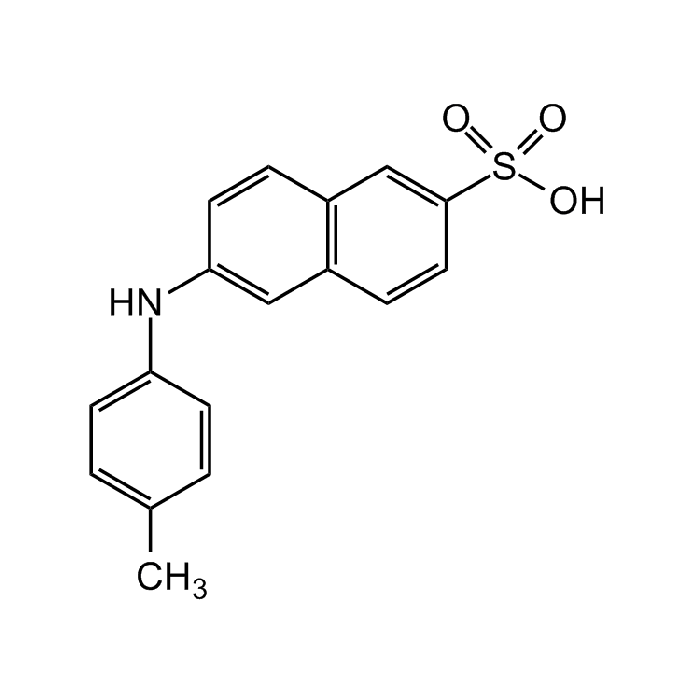Cookie Policy: This site uses cookies to improve your experience. You can find out more about our use of cookies in our Privacy Policy. By continuing to browse this site you agree to our use of cookies.
Chemodex
6-(p-Toluidino)-2-naphthalenesulfonic acid

| Product Details | |
|---|---|
| Synonyms | 2,6-TNS |
| Product Type | Chemical |
| Properties | |
| Formula |
C17H15NO3S |
| MW | 313.37 |
| CAS | 7724-15-4 |
| Purity Chemicals | 99% (HPLC) |
| Appearance | White to off white powder. |
| Solubility | Soluble in DMSO. |
| Identity | Determined by 1H-NMR. |
| Declaration | Manufactured by Chemodex. |
| Other Product Data |
Click here for Original Manufacturer Product Datasheet |
| InChi Key | VTRBOZNMGVDGHY-UHFFFAOYSA-N |
| Smiles | OS(C1=CC(C=CC(NC2=CC=C(C)C=C2)=C3)=C3C=C1)(=O)=O |
| Shipping and Handling | |
| Shipping | AMBIENT |
| Short Term Storage | +20°C |
| Long Term Storage | +4°C |
| Handling Advice | Protect from light and moisture. |
| Use/Stability | Stable for at least 2 years after receipt when stored at +4°C. |
| Documents | |
| Product Specification Sheet | |
| Datasheet |
 Download PDF Download PDF |
6-(p-Toluidino)-2-naphthalenesulfonic acid (TNS) is a widely recognized aminonaphthalene-based fluorescent probe characterized for its solvatochromic effect. TNS is found to be almost fluorescence silent in aqueous medium whereas shows a high quantum yield in organic solvents with a hypsochromic shift, as the polarity of the medium decreases. This property has been exploited in biological studies to probe the micellation properties of surfactants, membrane fluidity, hydrophobic surfaces on proteins, conformational changes upon ligand binding, ligand binding events, protein-surfactant interactions, multimeric protein assembly or aggregation, fibril formation and others. TNS has been used in many studies as environmentally sensitive fluorescent probe for the conformational state of proteins. TNS fluorescence enhancement upon binding to unfolded states of proteins might be due to the hydrophobic environment and reduced solvent accessibility rather than the binding ability and specific orientation of TNS in the bound state. Studies suggest that TNS forms aggregates in water whereas in non-aqueous solvents the order of aggregates is lower which might result in an enhancement of its fluorescence intensity. Further, TNS preferably interacts with basic and aromatic amino acid residues of the proteins. TNS is a well characterized fluorescent probe of protein structure that fluoresces in nonpolar environments but is quenched and red-shifted in solution. Spectral data: λex 320nm; λem ~440nm.
(1) J.R. Lakowicz & D. Hogen; Biochemistry 20, 1366 (1981) | (2) G.V. Ohning & K.E. Neet; Biochemistry 22, 2986 (1983) | (3) J.R. Lakowicz & S. Keating-Nakamoto; Biochemistry 23, 3013 (1984) | (4) G. Maniara, et al.; Photochem. Photobiol. 47, 207 (1988) | (5) E. Bismuto, et al.; Biochemistry 28, 7542 (1989) | (6) Y. Dotskias, et al.; J. Pharma. Biomed. anal. 23, 997 (2000) | (7) N. Pattaramanon, et al.; Biochemistry 46, 3405 (2007) | (8) N. Haque & N.P. Prabhu; J. Mol. Struct. 1068, 261 (2014) | (9) N. Haque, et al.; Phys. Chem. Chem. Phys. 19, 24656 (2017)





